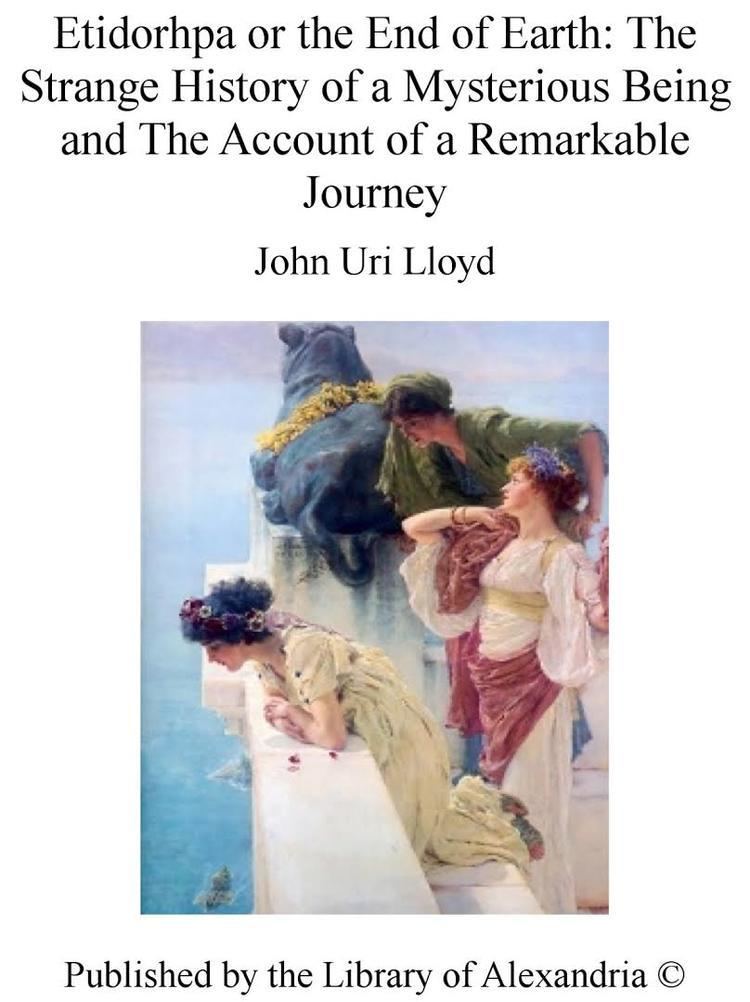8.4 /10 1 Votes8.4
Illustrator John Augustus Knapp Publisher privately printed Genres Science Fiction, Fantasy | 4.2/5 Goodreads Language English Publication date 1895 Originally published 1895 Country United States of America | |||||||||||||||||||||||||||||||||
 | ||||||||||||||||||||||||||||||||||
Similar John Uri Lloyd books, Science Fiction books | ||||||||||||||||||||||||||||||||||
Etidorhpa the end of the earth part 1 of 60
Etidorhpa, or, the end of the earth: the strange history of a mysterious being and the account of a remarkable journey is the title of a scientific allegory or science fiction novel by John Uri Lloyd, a pharmacognocist and pharmaceutical manufacturer of Cincinnati, Ohio. Etidorhpa was published in 1895.
Contents
The word "Etidorhpa" is the backward spelling of the name "Aphrodite." The first editions of Etidorhpa were distributed privately; later editions of the book feature numerous fanciful illustrations by John Augustus Knapp. Eventually a popular success, the book had eighteen editions and was translated into seven languages. Etidorhpa literary clubs were founded in the United States, and some parents named their infant daughters Etidorhpa.
Concept
The book purports to be a manuscript dictated by a strange being named I-Am-The-Man to a man named Llewyllyn Drury. Drury's adventure culminates in a trek through a cave in Kentucky into the core of the earth. Ideas presented in Etidorhpa include practical alchemy, secret Masonic orders, the Hollow Earth theory and the concept of transcending the physical realm.
Hollow Earth
Etidorhpa belongs to a subgenre of fiction that shares elements of science fiction, fantasy, Utopian fiction, and scientific (or pseudo-scientific) speculation. Jules Verne's Journey to the Center of the Earth is the most famous book of this type, though many others can be cited. It imagined another world in the center of a hollow earth.
Among John Uri Lloyd's generation, Bulwer Lytton's The Coming Race was popular and influential. During the next generation, Edgar Rice Burroughs wrote a series of hollow earth novels.
In Tanis Helliwell's non fiction book Summer with the Leprechauns, she claims to meet a being from the hollow earth. He tells her he is the same being written about in the book Etidorpha.
Drugs
Since Lloyd was a pharmacologist, his novel has provoked speculation that drug use contributed to its fantastic and visionary nature. Substances from marijuana and opium to nightshade, henbane, jimsonweed, and psilocybin mushrooms have been suggested as possibilities—though no real evidence on the matter is available.
Synopsis
The complex structure of the books begins with a Preface signed by Lloyd, which presents the frame concept, that Lloyd has discovered a thirty-year-old manuscript by Llewellyn Drury in a library. Then comes a Prologue in which Drury introduces himself.
The book's Chapter I begins the story of how Drury met the mysterious "I-Am-The-Man", who reads his own manuscript account of his adventures to Drury over many sessions. The mysterious stranger, also known as The-Man-Who-Did-It, relates events that supposedly occurred thirty years earlier, during the early part of the nineteenth century.
By his account, the speaker is kidnapped by fellow members of a secret society, because he is suspected to be a threat to their secrecy. (This was likely based on the 1826 kidnapping of William Morgan and the start of the Anti-Masonry movement.) I-Am-The-Man is taken to a cave in Kentucky; there he is led by a cavern dweller on a long subterranean journey. It becomes an inner journey of the spirit as much as a geographical trip through underground realms.
The book blends passages on the nature of physical phenomena, such as gravity and volcanoes, with spiritualist speculation and adventure-story elements (like traversing a landscape of giant mushrooms). The whole ends with a summary letter from "I-Am-The-Man" and a conclusion from Drury. Subsequent editions of the book added various prefatory and supplementary materials.
Although the secret society is not named, the narrator is made to take an oath by raising his hand and repeating after a man who acts as his guide, "To all this I most solemnly and sincerely promise and swear, with a firm and steadfast resolution to keep and perform my oath, without the least equivocation, mental reservation, or self-evasion whatever," reminiscent of initiatory oaths of multiple degrees in Masonry. And a man the narrator encounters around the end of the novel says "The future is operative and speculative," reminiscent of "operative" and "speculative" Freemasonry and the "speculative science and the operative art" in Freemasonry.
